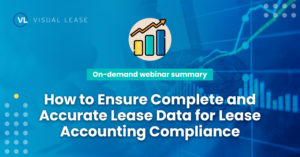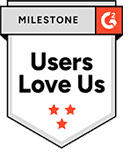
On-demand webinar summary
Before the new lease accounting standards, many companies lacked visibility into their lease portfolio. This cost many businesses millions of dollars in overpaid rent, missed lease options and more.
But now, leases are in the forefront as companies prepare for and maintain compliance with the new standards. However, many businesses struggle to ensure their lease data is comprehensive and up-to-date.
In our recent webinar, How to Ensure Complete and Accurate Lease Data for Lease Accounting Compliance, experts shared best practice tips to ensure a thorough lease portfolio.
High-level key takeaways from the webinar include:
- Common challenges and solutions for gathering and auditing lease data
- Key advantages of using dedicated lease accounting technology
To learn more, view the on-demand webinar or read the summary below.
Common challenges and solutions when gathering and auditing lease data
1. Ensuring a comprehensive lease portfolio is time-consuming
Many businesses have hundreds, if not thousands, of leases. To achieve and sustain lease accounting compliance, you need to have complete visibility into all your leases.
However, gathering all your leases is time-consuming and laborious, and involves various departments.
The sooner you begin, the better, to give your team enough time to identify and locate every lease across your business. If needed, you may want to hire third-party advisors experienced in lease accounting preparation to assist in this effort.
2. Gathering lease data requires cross-departmental resources
Because leases are typically scattered throughout various departments, you should identify all key stakeholders responsible for identifying leases up-front, including real estate, procurement, legal, IT and more.
From there, this cross-functional team can work together to develop a reliable and sustainable process for data collection and maintenance to ensure your lease portfolio is complete and always up-to-date.
3. Lease information is often not located in one location
Prior to the new lease accounting standards, leases weren’t commonly tracked. And any leases that were tracked were likely inconsistent across the business.
Once you’ve gathered all your leases for lease accounting compliance, it’s best to enter them in one single source of truth.
A centralized lease portfolio enables you to track lease data in real time – and result in much faster, efficient lease accounting.
4. Leases change often and must be maintained
Maintaining compliance is a continuous effort, given leases’ dynamic nature. Staying compliant requires ongoing attention and a reliable process to identify and capture any financial changes to your lease portfolio.
Without the right lease management software or tools, this can be extremely difficult to do.
Robust technology, like Visual Lease, enables businesses to maintain one single source of truth for their lease portfolio and set internal controls for ongoing lease data maintenance, therefore supporting data integrity and accurate, up-to-date information.
For more information, view the on-demand webinar, How to Ensure Complete and Accurate Lease Data for Lease Accounting Compliance.























